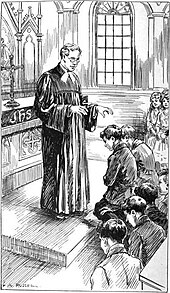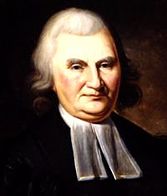Bands (neckwear)

Bands
The two bands are sometimes said to symbolize the two tablets of the Ten Commandments given by God to Moses.[1][dubious ]
Ruffs were popular in the sixteenth century, and remained so until the late 1640s, alongside the more fashionable standing and falling bands. Ruffs, like bands, were sewn to a fairly deep neck-band. They could be either standing or falling ruffs.[2] Standing ruffs were common with legal, and official dress till comparatively late. Falling ruffs were popular c. 1615 – c. 1640s.[2]
Origin
In the early sixteenth century bands referred to the shirt neck-band under a ruff. For the rest of the century, when ruffs were still worn, and in the seventeenth century, bands referred to all the variations of this neckwear. All bands or collars arose from a standing neck-band of varying heights. They were tied at the throat with band-strings ending in tiny tassels or crochet-covered balls.
Bands were adopted in
Clerical, legal and academic costume
Bands varied from small white turn-down collars and ruffs to point
The bands are two strips of bleached holland[f] or similar material, falling down the front from the collar. Plain linen 'falling bands', developed from the falling collar, replaced the ruff about 1640.[g] By 1650 they were universal. Originally in the form of a wide collar, tied with a lace in front, by the 1680s they had diminished to the traditional form of two rectangles of linen tied at the throat.

Bands did not become academically significant until they were abandoned as an ordinary lay fashion after the
For a time from the eighteenth century judges and
bands, which have a double pleat running down the middle of each wing or tongue, are still used by some barristers, clergy and officials.By the end of the seventeenth century King's Counsel wore richly laced cravats. From the later part of the eighteenth century they wore bands instead of the cravat as undress.[7] In the eighteenth century a lace fall was often used as an alternative to the bands by judges in full dress.[4]
Both falling and standing bands were usually white, lace or lace-edged cambric or silk, but both might be plain.[8]
The standing bands, a semi-circular collar, the curved edge standing up round the back of the head. While the straight horizontal edges in front met under the chin and were tied by band-strings, the collar occasionally was worn turned down. It was supported on a wire frame attached to the neck of the doublet behind. The starched collar rested on this. It was usually of linen, but also lawn[i] and lace.[9][page needed] They were popular for a quarter of a century.

The soft, unstiffened collar draped over the shoulders of the doublet were called falling-bands. Until the
Bands were adopted early in the eighteenth century by parish clerks and many dissenting ministers, as well as in Western Europe by junior Catholic clergymen/readers and those of many Protestant churches, soon followed by those in the lands governed/co-governed and settled overseas. The bands were fairly wide, set close together. The outer white edge is the hemmed linen fabric which, being turned over onto itself three times, is opaque.[11]

The falling bands, worn 1540s to 1670s, could take three forms. Firstly, a small turned-down collar from a high neck-band, with an inverted v-or pyramidal-shaped spread under the chin and tied by band-strings sometimes visible but usually concealed.
Relation to neckties
The cravat or neckcloth was popular 1665–1730.
In the 1840s several types of cravat were in use, the most traditional being a large bow with pointed ends. The variety of neckwear became very much greater in the 1890s. The
Until about 1950, apart from short-sleeved, open-necked sports wear, day shirts always had a long sleeve with cuffs, closed by links or buttons, and with a neck-band with separate collar fastened by studs, or an attached collar. The attached collar is now dominant.[14] The result is that bands are rarely used by graduates, who prefer the contemporary down turn collar and neck tie.
Notes
- ^ According to the Oxford English Dictionary, since the eighteenth century these have been called bands rather than by the singular band.
- ^ It is similar to jeans, another form of clothing that goes by the plural.
- Geneva gown.
- mercerized, soft-finished, lightweight, combed-yarn, converted, lawn-type fabric, bleached, dyed, and printed. It is used for women's and children's lingerie, nightgowns, summer dresses, infants' wear, lining.
- inns of court.[4]
- crape in the early nineteenth century and white cotton muslin in the late eighteenth century.[5] Mourning crape, or crepe anglais as it was called in France, was a transparent crimped dull black and white silk gauze, made by Courtaulds until production ceased in 1940.[6]
- ^ The falling collar, which had the collar turned down on the shoulders, was developed in the early seventeenth century. This largely replaced the ruff, although that continued well into the seventeenth century. Towards the end of the sixteenth century the ruff was sometimes worn open in front rather than completely encircling the neck. Both types of ruff retained the deep projecting starched frill of several separately goffered folds of linen or muslin, and supporting standard, which arose in the sixteenth century.
- DMusat Oxford were required to wear (very small) bands and cravat; all other doctors: bands alone.
- ^ A very light, fine, translucent, smooth, hard handling, plain woven fabric of linen now cotton or synthetic. Lawn usually more closely woven and stiffer than cambric.
- ^ Band-strings were the ties used for fastening neckwear,[12] whether bands or ruffs.
- ^ Of the several varieties of plain weave cotton cloth, the thin batiste and nainsook, rather than the heavy sheeting such as longcloth and percale. Muslin, or muzline, is a finely woven, lightweight cotton fabric with a downy surface. Named after the town of Mosul, near Nineveh, it was introduced into England from India circa 1670. Machine-made by the 1780s, it gradually replaced linen hollands and cambrics.[13]
- ^ Popular for evening wear in a white material such as piqué, a stiff, ribbed cotton fabric. This is the shape modern neckties are tied in. In the early twentieth century the "bow" tie was more popular, from the 1920s the knotted one.
References
Footnotes
- ^ Kusi, Cynthia Agyeiwaa; Quansah, Sarah Asheley; Boakye-Yiadom, Fredrick (2019). "'Decoding' the Clerical Vestments of the Methodist Bishop in Charge of Sekondi Dioceses". Fashion and Textiles Review. 1 (2): 83.
- ^ a b Cunnington & Cunnington 1972, pp. 34–35.
- ^ Hargreaves-Mawdsley 1963, p. 40.
- ^ a b Hargreaves-Mawdsley 1963, p. 66.
- ^ Beck 1886, p. 164.
- ^ Beck 1886, p. 70.
- ^ Hargreaves-Mawdsley 1963, p. 86.
- ^ a b Cunnington & Cunnington 1972, p. 34.
- ^ a b Cunnington & Cunnington 1972.
- ^ Hargreaves-Mawdsley 1963, p. 90.
- ^ Mayo 1984.
- ^ Planché 2003, p. 33.
- ^ Beck 1886, p. 231.
- ^ Sichel 1978, p. 16.
Bibliography
- Beck, William (1886). The Draper's Dictionary. London: The Warehousemen and Drapers Journal.
- Cunnington, C. Willett; Cunnington, Phillis (1972) [1955]. Handbook of English Costume in the 17th Century (3rd ed.). London: Faber & Faber.
- Hargreaves-Mawdsley, W. N. (1963). A History of Legal Dress in Europe until the End of the Eighteenth Century. Oxford: Clarendon Press.
- Mayo, Janet (1984). A History of Ecclesiastical Dress. New York: Holmes & Meier Publishers.
- ISBN 978-0-486-42323-4.
- Sichel, Marion (1978). Costume Reference. Batsford. ISBN 978-0-7134-1507-0.
Further reading
- Cox, Noel (2000). "Bands". Academical Dress in New Zealand. Archived from the original on 27 October 2009. Retrieved 12 March 2018.


